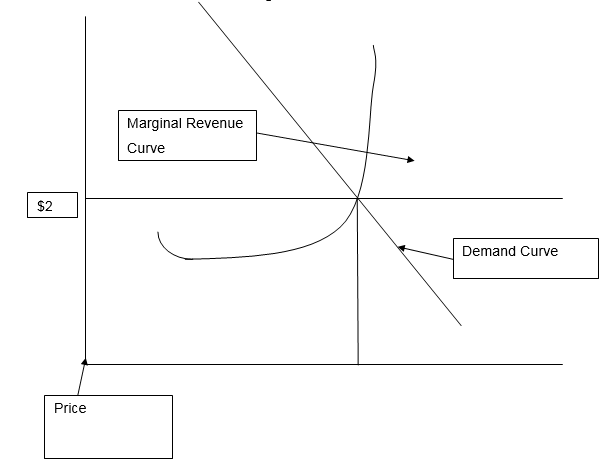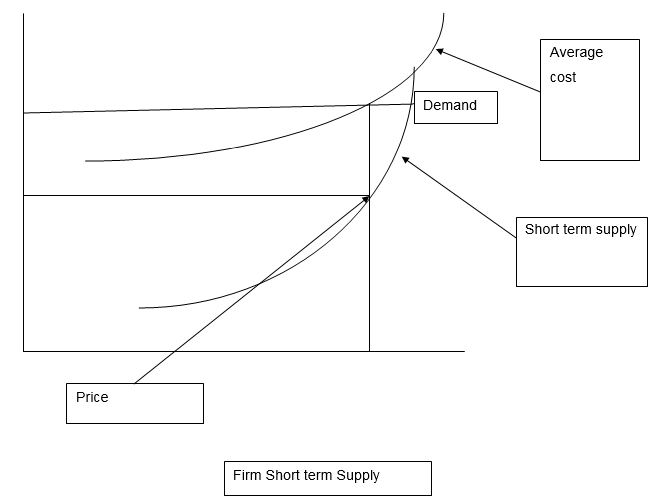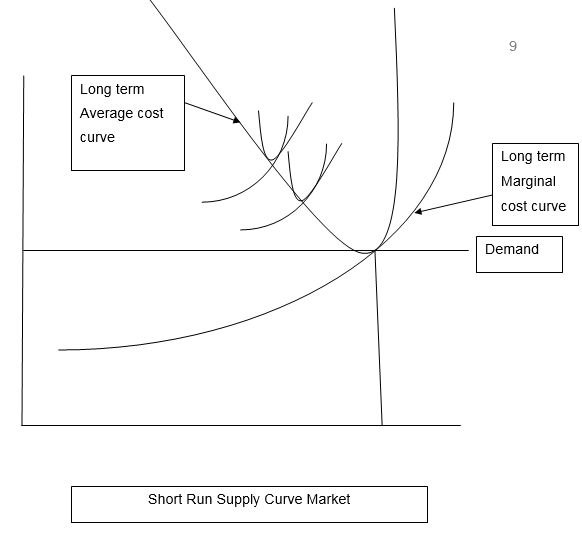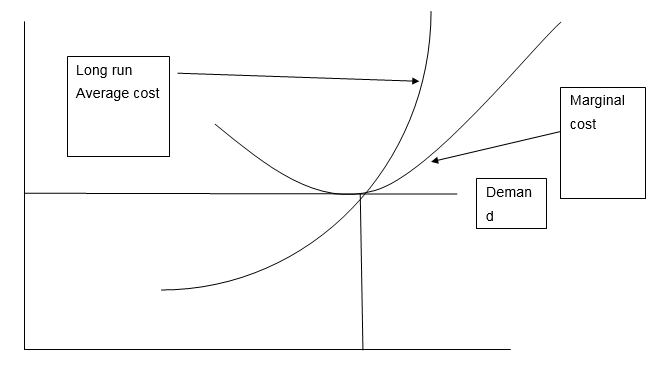Case Study: Competitive Markets Assignment Help
Section 1 : Competitive Market Basics
Pick 2 out of the following three markets. Make a case for perfect competition being an appropriate model for each of those markets:Milk Commercial real estate
NYSE (the New York Stock Exchange)
Make a graph with the demand curve and the marginal revenue curve for a milk producer in a perfectly competitive market with a market price of $2.00. In 1 or 2 sentences, interpret the marginal revenue curve in your own words.
Section 2 : Competitive Markets in the Short-run
For the purposes of this problem, the quantity produced (Q) will be measured in units of 100,000 pounds. Prices and costs will be measured in $thousands. Note that the units do not affect your method of solving the profit-maximization problem as long as the units are consistent. However, you should convert the quantities and prices back to single pounds and dollars at the end.
The wholesale price of milk (p) is 19 ($thousand). As a milk producer, you face various variable, fixed, and sunk costs as follows. The cows cost three thousand dollars per 100,000 pounds of milk produced (C=3Q). You own the cows but the cows can easily be resold, so the (C=3Q) is like a wage paid on your investment in the cows. Your workers cost an amount per cow that increases as the size of your herd grows because it becomes more difficult to manage (C=Q+1/2 Q^2). Care for the cows costs one thousand dollars per 100,000 pounds of milk produced (C=Q). You own your land and cannot readily resell it. The mortgage for the land costs 80 thousand dollars (C=80). You also own outdated machinery used to collect and store the milk that cost 100 thousand dollars when you purchased it, but the machinery cannot be resold or used in any way (so it is a sunk cost).
Categorize each of the costs as variable, fixed, or sunk. What is your profit-maximizing output? What are your profits (or losses) in the short-run? Would you shutdown in the short-run? If other firms face the same costs as your farm, do we expect the industry to experience entry or exit?
What happens to the profit maximizing output you produce if the rent on the land falls 25% to $60,000? What happens to the profit maximizing output you produce if you had paid $200,000 for your milking machinery? Describe why these results intuitively make sense in this setting.
Graph the short-run supply curve for your farm. On a separate graph make a short-run supply curve for the market if it contains 1,000 farms that have the same costs as your farm.
Section 3 : Competitive Markets in the Long-run
Now let's consider your farm in the long-run. In the long-run, the market price adjusts to 16 ($thousand). Because you have more flexibility in your land, machinery, and labor usage in the long-run, your long-run costs differ from your short-run costs and are described by the function:

a. What is your profit-maximizing output? What are your profits (or losses) in the long-run? Is that what we expect?
b. Graph the demand curve, long run marginal cost, and long-run average cost for your farm.
c. Suppose market demand is Q=40,000-1,000P. What is the equilibrium number of firms?
d. Suppose that the public becomes aware of scientific research indicating that the hormones in milk are dangerous to children whichshifts demand to Q=35,000-1,000P. Roughly speaking, what happens to the quantity produced by each farm and the number of farms in the short-run? Roughly speaking, what happens to quantity produced by each farm and the number of farms in the long-run?
Are you looking for reliable Case Study: Competitive Markets Assignment Help solution? Expertsminds.com is right choice as your study partner!
1. Introduction
In this report, the different aspects of the competitive markets will be discussed. The first aspect which will be discussed is the perfect competition market model in the milk and NYSE market. The second aspect which will be discussed is the competitive market in the short run. The third aspect which will be discussed is the competitive market in the long run. In the end, the findings of this report will be discussed.
2. Section 1 - Competitive Market Basics
2.1 Milk Market - Perfect Competition Market
The milk market is one of the examples which show how a perfect competition market operates like all the characteristic of the perfect competition exist in the Milk Market. The first characteristic of this market model that exists in the Milk market is that there are many sellers in the market as there is a low barrier to entry and exit in this market for the seller. This low barrier to entry and exit is because low investment capital is needed to operate in this market, which makes this market more accessible to the new sellers (Eatwell, 2016). Also, the rules and regulation of the milk market are very limited compared to the other markets, which make it easier more the sellers to access this market. Another characteristic which exists in this market is uniformity of price as the most of the customers are aware of the price that other sellers are charging for selling a particular quantity of milk in the market. The third characteristic which exists in this market is the price level of milk is decided by the demand and supply in the market (Muñoz, 2019). For example, in any festive day when the different food items are made in the households by milk, there is a high demand of milk in the market, and then many local sellers' increases the price of the milk. Another example is supposed in a region, there is a culture of having milk drink daily, but there is a low number of sellers in that region, then the price of milk will be higher in that market. The last characteristic of this market which matches with the perfect competition market is that technologies used in the milk market are mostly used by all sellers in the US market as the use of technology is lower in this market compared to other markets. All these factors show that the Milk market in the US is a perfect competition market.
2.2 NYSE (the New York Stock Exchange) -Perfect Competition Market
New York Stock Exchange is also another example of perfect competition market as there are many characteristics of the perfect competition which matches with NYSE market. The first characteristic is that price level is decided by the supply and demand in the market as the share price of the company listed in NYSE and trading in it depend on the depend on the demand of that company's share price and what rate the investors are ready to pay for it(Azevedo & Gottlieb, 2017). The second characteristic is that every investor in the market is aware of the share price of every company are share price keep on shown in real time in this market and this fulfil another characteristic of this discussed market model. The third characteristic which is fulfilled by this market is there are many sellers as there are many companies which are listed in NYSE. The last characteristic is that almost all investors and companies used the same technologies to operate in this market. Therefore, it can be seen that NYSE is considered as a perfect competition market model.
2.3 Demand Curve and Marginal Revenue Curve of Milk Producer

Interpretation of the Marginal Revenue Curve
In this curve, it can be seen that in the marginal revenue was low in the initial stage. After, which when the demand and supply meet marginal revenue was equal to the price of the product which is, in this case, is $2, then it increased in the keep on increasing.
3. Section 2- Competitive Markets in the Short-run
a) Categorize each of the costs as variable, fixed, or sunk. What is your profit-maximizing output? What are your profits (or losses) in the short-run? Would you shut down in the short-run? If other firms face the same costs as your farm, do we expect the industry to experience entry or exit?
There are different types of cost in the discussed farm in the short run, and these will be costs will be discussed here. The first cost, which is cows cost three thousand dollars per 100,000 pounds of milk produced is variable cost as the equation of this cost clearly show the total amount of this cost depend on the quantity produced. The second cost, which is the amount needed to manage cow herd, is also a variable cost as it also depends on the quantity of production. The third cost, which is caring for cow cost is also variable cost as it also totally depends on the production quantity. The fourth cost which is the mortgage cost of land is a sunk cost and also a fixed cost as it cannot be recovered and will remain same in all production level of the farm.
The Profit maximising formula in the short run is Marginal cost = Marginal Revenue = Price. In this case, there will be no profit maximising unit as the price of the milk is lower per 100000 compared to the marginal cost of the business. The total marginal cost per 100,000 pounds is $25,5080 compared to $19000 price. Therefore, the loss of the business in the short run is -236080.
Yes, the firm will shut down in the short run due to experiencing the economic loss in its operation.
If the other firms face the same cost as this farm, then this industry can experience the exit of many other firms from this market as all these firms will face economic loss in this market.
b) What happens to the profit-maximizing output you produce if the rent on the land falls 25% to $60,000? What happens to the profit-maximizing output you produce if you had paid $200,000 for your milking machinery? Describe why these results intuitively make sense in this setting.
The profit maximising output in the short run will not be affected by the rent on land as it is a fixed cost, and the marginal cost of the business is not affected by the fixed cost. Therefore, this cost reduction may affect profit maximisation in the long run but will not affect the business in the short run as Marginal Revenue is equal to Marginal cost in the short run. The milking machinery is another fixed cost of the business which does not affect the profit maximising output in the short run as this cost is also not dependent production increase or decrease.
c) Graph the short-run supply curve for your farm. On a separate graph, make a short-run supply curve for the market if it contains 1,000 farms that have the same costs as your farm.


4. Section 3- Competitive Markets in the Long-run
a) What is your profit-maximising output? What are your profits (or losses) in the long-run? Is that what we expect?
The profit maximising output will be 260036 and there will be loss, in the long run, as the cost per pound is $26, but the price per pound will be $1.6. No, this is not we expect as, in the long-term, the farms earn normal profit in the long run in the market.
b) Graph the demand curve, long-run marginal cost, and long-run average cost for your farm.

c. Suppose market demand is Q=40,000-1,000P. What is the equilibrium number of firms?
In this above case, the demand quantity is 24,000. Then the equilibrium number of firms should be one as the production which the company has to produce more than 40000 to breakeven.
d. Suppose that the public becomes aware of scientific research indicating that the hormones in milk are dangerous to children, which shifts demand to Q=35,000-1,000P. Roughly speaking, what happens to the quantity produced by each farm and the number of farms in the short-run? Roughly speaking, what happens to quantity produced by each farm and the number of farms in the long-run?
The quantity of production per farmer will reduce in this case, and the number of farms will also reduce in the short run.
The quantity of produced will lowers more than before in the long run, but the new equilibrium number of farmers will exist in the long run.
5. Conclusion
In this report, the different aspects of the perfect competition market have been described in both long term and short term aspects. It has been found that profit-maximizing the output of a firm is completely different, and it has been discussed in this case study report.
Do you want to excel in assignment? Hire trusted tutors for Case Study: Competitive Markets Assignment Help solution from Expertsminds and achieve success!